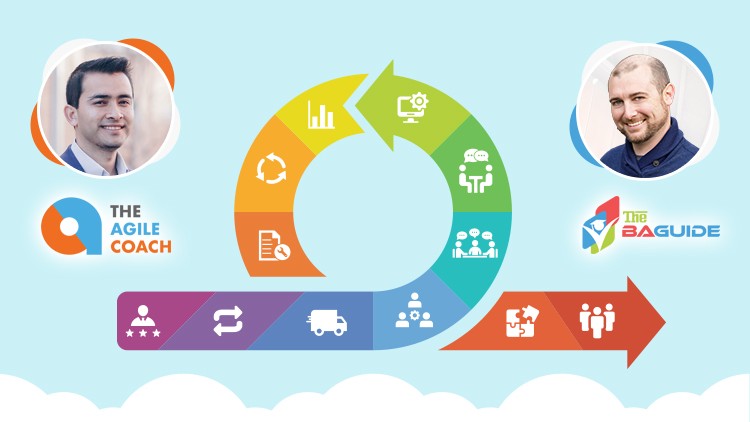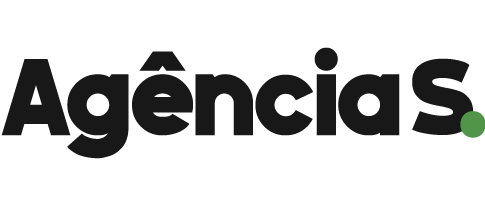Agile Fundamentals: Including Scrum & Kanban
- Descrição
- Currículo
- FAQ
- Revisões
Make yourself a more valuable member of the team by learning how to help organizations make changes faster and with less expense by using Agile approaches.
In nature, as in business – you adapt, or you die…
And with over 70% of companies using Agile for their projects, not knowing the fundamental concepts, principles, and values just isn’t an option anymore.
This course will not only teach you the fundamentals of Agile to help you develop the adaptive mindset, but it will also break down the most popular Agile frameworks such as Scrum, Kanban, and Scrumban.
That includes:
– Agile Values
– Agile Principles
– Benefits of Agile
– Challenges
– Roles in Agile
– User Stories
– Scrum Framework
– Sprints
– Scrum Ceremonies
– Product Backlog
– Sprint Backlog
– Estimation Techniques
– Team Velocity
– Burndown Charts
– Burn Up Charts
– Kanban Principles
– Setting Work in Progress (WIP) Limits
– Kanban Boards …and more!
Taught with practicality and authenticity in mind, this to-the-point course brings you real-life work examples (both failures and successes) to make your learning stick.
Course enrollment grants you lifetime access, with no expiration, to all the course lectures, activities, handouts, and quizzes. In addition, you’ll also receive 1-on-1 support for any questions or uncertainties that come up. And this all comes with a money-back guarantee. You have nothing to lose and so much knowledge to gain.
Just ask the students who’ve already taken this course:
“This course is awesome! I am a beginner, I just started exploring Agile and Scrum, and after this course I feel like I’m ready to implement things. Thank you so much. Great work!” – Dubravka
“The course structure is a lot more than I was expecting regarding features. I can also make notes during the video without pausing or falling behind. I’m […] impressed with how the sections are broken down and have been placed into chronological order to help with understanding.” – Laura
“Through my Agile journey, this is one of the top courses I have taken. Why? I enjoy this course because it goes over a large scheme of topics that are specific and useful, but also given to the learner in bite sized pieces.. This course is especially helpful if you are working in an Agile Team or looking to implement Agile into a team. I have a much clearer understanding on the ceremonies, structure of a team, team responsibilities and reasoning behind different pieces of software, such as Jira. I have gained a lot of knowledge from the course, quizzes, and activities that Jeremy and Vivek put together. I can absolutely see myself implementing what I have gained from this course into my team and future teams. Thanks for creating an easy to follow course!!” – Meghann
Learn how Agile works as well as how it fits into the world of Business Analysis
This course is taught by two instructors, to ensure you get total coverage of the subject.
Jeremy Aschenbrenner (The BA Guide) is an expert in the Business Analysis field who will help you understand the part Agile plays in the Business Analyst role…
Vivek Khattri (The Agile Coach) is a highly experienced Agile practitioner and trainer whose expertise will give you a comprehensive understanding of Agile, Agile Mindset, and different Agile frameworks and practices…
And together, not only will our varying perspectives give you a 360-degree understanding of Agile fundamentals, our varied content formats will enhance your learning experience and help you retain the concepts you learn.
Let’s hear from some more students:
“I was certified as a Scrum Master over a decade ago and had been away from using scrum in a product management role for several years. This course helped me quickly regain an overview of the key principles and remind me of all of the artifacts and other key practices to put scrum to use again. I highly recommend this course to anyone who wants to understand Scrum or Kanban.” – John
“Training by Jeremy and Vivek was awesome. They were able to explain in detail about all the concepts which will help anyone to understand and try to implement these practices. The good thing about Jeremy is his technique to break into pieces and explaining to avoid confusion. Look forward to learning more from you guys in the future lectures.” – Venkatesh
What’s included in the course?
– High-Quality Video Lectures break down the complex terms and confusing Agile jargon to ensure you get a concrete understanding of the items being discussed
– Downloadable Handouts help you to enhance your understanding and retention of the key concepts
– Quizzes and Activities validate your learning and help to point out areas that should be reviewed for full comprehension
– 1-on-1 Support means that any confusion or questions you have can be addressed and cleared up easily (no more frantically googling trying to figure out what your course instructor means).
– Lifetime Access with NO Expiration so you can learn at your own pace, and come back at any time you feel unsure or are in need of a refresher
“Not only the theoretical part associated to the Scrum Framework is good, but Jeremy and Vivek’s experience, that is invaluable, thanks for that guys! […] Jeremy and Vivek explained the terms and concepts in a logical and simple order way so it was much much easy to me to catch on all these concepts once and for all. Congrats to both!” – Silvia
“While not 100% new to Agile, it had been some time since I worked in the environment so as a refresher this course is perfect. I also feel this would be a great course for beginners. The videos are clear and easy to listen to, with a good pace. I like the inclusion of printable material as it is true, when you write something down, you remember it easier. Well done Vivek and Jeremy.” – Shelly
What ELSE is included in the course?
And of course, anyone who has studied one of Jeremy’s courses before will know, it simply wouldn’t be a course by The BA Guide if I didn’t include some value-packed bonus material!
Here’s what you get as complimentary extras with the Agile Fundamentals course:
– The Agile Principles Handout and Infographic
– Sample User Stories
– Scrum Terms Worksheet
– Scrum Terms Retention Worksheet
– Checklist for starting Kanban with your team
– Digital Kanban board setup instructions
– Agile Word Search
– Agile Terms Crossword Puzzle
Still not convinced?
And if you’re still not sure – here’s my promise to you:
This course comes with a 30-day money-back guarantee! That means, if you aren’t completely satisfied with your purchase, I’ll give you a refund – no questions asked!
By the end of this course, you’ll have a working understanding of the fundamentals of Agile as well as its most popular frameworks, setting you up to be the agile, adaptive Business Analyst every modern organization needs.
As one of my favorite ancient Chinese proverbs says, “when the winds of change blow, some build walls, others build windmills”.
With disruptive technology evolving at a faster rate than ever before, the winds of change are blowing.
Hard.
So, if you’re ready to build windmills, enroll today and get started learning the fundamentals of Agile.
-
1Course IntroductionVídeo Aula
-
2Introducing Your Instructors - Jeremy and VivekVídeo Aula
It is great to virtually meet you!
-
3IMPORTANT LINKS: Please review and bookmarkTexto
In this lecture, we provide you links to several critical items including a tour of Udemy's features, frequently asked questions, and more.
-
4Course Resources - for your convenienceTexto
In this lecture, we provide you a ZIP file that contains all of the downloadable resources for the course. While those downloads are still available on appropriate lectures throughout the course, we're providing this ZIP file for convenience and to avoid some of the nuances and issues with downloading the files individually. It is our recommendation that you download this file now and then pull up the files as they are referenced within the course. Happy learning!
-
5Introduction to AgileVídeo Aula
To start off the course, we explain the origins of Agile and gain an understanding of what Agile is all about.
Terms: Agile, Agile Manifesto, agile mindset
-
6Adjusting Course SpeedTexto
As some students like to learn at a faster pace, while others prefer slower, this lecture includes some simple instructions to adjust the playback rate of the course.
-
7Agile Manifesto: Agile ValuesVídeo Aula
In this lecture, we discuss the four main Agile Values as described in the Agile Manifesto.
Terms: Agile Manifesto, agile values, stakeholder, agile mindset
-
8ACTIVITY: Agile Terms Word SearchTexto
This is a fun activity to get you familiar with some of the Agile terms that you will hear repeatedly throughout the course.
-
912 Agile PrinciplesVídeo Aula
In this lecture, we break down the twelve Agile Principles as described in the Agile Manifesto and we provide our insight as to what makes the principles so important and how they can be applied to your projects.
Terms: Agile principles, self-organizing
-
10Agile Principles Downloadable ResourcesVídeo Aula
Here we introduce you to some resources that you can download and print off to use a reference or study guide on the twelve Agile principles.
-
11Udemy Review PromptTexto
-
12ACTIVITY: Your Top 5 Agile PrinciplesVídeo Aula
In this activity, we challenge you to come up with your top 5 Agile principles are and share them and your reasoning with Jeremy, Vivek, and the other students of the course.
-
13Activity Response: Jeremy, The BA GuideVídeo Aula
Here Jeremy works through his top 5 Agile principles and gives you his thoughts.
-
14Activity Response: Vivek, The Agile CoachVídeo Aula
Here Vivek works through his top 5 Agile principles and gives you his thoughts.
-
15Benefits of Using AgileVídeo Aula
Now that we've covered some of the important aspects of the Agile Manifesto, it is time we take a step back and talk about some of the benefits of using Agile over other more traditional project approaches.
Terms: Waterfall, agile
-
16Challenges of Using AgileVídeo Aula
As with any project approach, there are challenges that come out of using it. In this lecture, we explore some of those challenges so we can understand why not all companies have switched over to using Agile.
Terms: Agile, agile mindset
-
17Setting the Stage for the Remainder of the CourseVídeo Aula
This lecture helps us transition from talking about Agile in general to talking about various project frameworks that have Agile at their center.
Terms: Agile, scrum, kanban, scrumban
-
18Validating the Agile conceptsQuestionário
-
19Scrum OverviewVídeo Aula
Scrum is the most popular Agile framework, so that is where we will start. In this lecture, you will learn about Scrum's terminology, ceremonies, and artifacts.
Terms: Scrum, product backlog, sprint backlog, sprint planning, retrospective, sprint review, daily standup, sprint, cross-functional, self-organizing, inspection, adaption, transparency
-
20Scrum ValuesVídeo Aula
Scrum is built around five core values. In this lecture, we will explore and explain those values and why they are important.
Terms: Scrum values, openness, focus, courage, commitment, respect
-
21Scrum Roles OverviewVídeo Aula
Within Scrum, there are three main prescribed roles - Scrum Master, Product Owner, Development team. In this lecture, we explore these roles and discuss their core responsibilities.
Terms: Product owner, scrum master, development team, user story, product increment
-
22Role of a Scrum Master - A ConversationVídeo Aula
In this lecture, we further explore the responsibilities of a Scrum Master, and Vivek discusses his recent experience in the Scrum Master role.
Terms: Scrum master, sprint, daily standup, sprint review, sprint retrospective
-
23Role of a Product Owner - A ConversationVídeo Aula
The role of the Product Owner is very important to explore and understand the vision of the business and then deliver that vision to the strategists (the Development Team) who can make it come to reality.
Terms: Product owner, user story, MVP, scrum master
-
24Role of the Developers - A ConversationVídeo Aula
The Development Team is a cluster of all of the other folks on the project team besides the Scrum Master and Product Owner. This includes Business Analysts, Quality Analysts, Developers, Architects, etc.
Terms: Development team, business analyst, developer, product owner
-
25Updates to Scrum StandardsTexto
-
26Verifying your Scrum KnowledgeQuestionário
-
27Backlog Refinement - A ConversationVídeo Aula
Backlog Refinement is where the team ensures the user stories in the Product Backlog are accurate and contain enough details for them to be worked. When they find high-priority stories that don't have enough details, the team works to get those details identified and added to the story.
Terms: Backlog grooming, backlog refinement, sprint, sprint backlog, product backlog
-
28Example Calendar ViewsVídeo Aula
All of these ceremonies are great, but sometimes they can be confusing until they are put into context. In this lecture, we walk through some examples of what your calendar could look like if your project had a one-week Sprint versus the two-week variety.
Terms: Sprint, sprint planning, daily standup, backlog refinement, backlog grooming, sprint review, sprint retrospective, user story
-
29Confirming your learning on ceremoniesQuestionário
-
30User StoriesVídeo Aula
This lecture kicks off our section on Scrum Terms and Artifacts and where better to start, User Stories. Come explore what User Stories are and why they are used.
Terms: user story, product increment
-
31User Stories: Acceptance CriteriaVídeo Aula
One important aspect to gain more details about the User Story is Acceptance Criteria. In this lecture, we will explore what Acceptance Criteria are and how they can be used to bring additional value to your requirements.
Terms: acceptance criteria, user story
-
32Writing Great User StoriesVídeo Aula
Great User Stories follow the INVEST principle. In this lecture, we will break down the acronym INVEST and teach you what it is important.
Terms: INVEST, user story
-
33User Story ExamplesVídeo Aula
Attached to this lecture is a downloadable resource to give you some examples of how User Stories and their Acceptance Criteria could appear in projects.
Terms: user story, acceptance criteria, wireframe
-
34Product Backlog and Sprint BacklogVídeo Aula
The Product Backlog and the Sprint Backlog are two key artifacts within Agile Scrum. In this lecture, we explain how they are used to help understand the work yet to be done, as well as the stories that are committed to within this iteration.
Terms: product backlog, sprint backlog, sprint planning, priority, sprint
-
35Working AgreementsVídeo Aula
Projects are multiplayer games, so it is important to have an agreement on rules, expectations, and procedures that govern the team. And those are handled by Working Agreements, which we will discuss within this lecture.
Terms: working agreement
-
36Definition of ReadyVídeo Aula
In this lecture, you will learn about how the Definition of Ready (DoR) helps the team to understand when a User Story contains enough details to be worked.
Terms: Definition of ready, working agreement, user story
-
37Definition of DoneVídeo Aula
The Definition of Done (DoD) is an agreement that ensures the team has a clear understanding of when a User Story can be considered done or complete. In this lecture, we explore the document and understand what having a common understanding of done is so important.
Terms: Definition of Done, user story, acceptance criteria
-
38Casual Conversation about Definition of Ready and Definition of DoneVídeo Aula
In this lecture, Vivek and Jeremy sit down and discuss the Definition of Ready and the Definition of Done to help bring some context to the artifacts.
Terms: definition of ready, definition of done
-
39Product IncrementVídeo Aula
In this lecture, you'll learn about how Product Increments are used in Agile Scrum to help deliver value after each iteration.
Terms: Product increment, Scrum, Waterfall
-
40More Scrum Knowledge ValidationQuestionário
-
41Introduction to EstimatingVídeo Aula
In this lecture, we explain the concept of estimating and how teams come up with their estimates.
Terms: agile, estimate
-
42Estimating in AgileVídeo Aula
Now that you understand what estimating is, let's compare the difference between estimating in a Traditional project versus those done in Agile.
Terms: agile, estimate, agile, waterfall
-
43Estimating in Agile: Why Estimate?Vídeo Aula
This lecture explores why estimating is important, regardless of the project approach that you are using.
Terms: agile, estimate
-
44Estimating in Agile: Estimation Techniques (Part 1 of 2)Vídeo Aula
While there are quite a few different estimation techniques that can be used within projects, we explore three of the most popular. (part 1 of 2)
Terms: estimate, BUS, t-shirt sizes
-
45Estimating in Agile: Estimation Techniques (Part 2 of 2)Vídeo Aula
While there are quite a few different estimation techniques that can be used within projects, we explore three of the most popular. (part 2 of 2)
Terms: estimate, fibonacci
-
46Estimation QuizQuestionário
-
47Overview of the Other Agile RolesVídeo Aula
Even though Agile only really recognizes three main roles, there are other roles that are equally as important to understand. In this lecture, we will explore those roles at a high level and then dig further into them throughout the remainder of the section.
Terms: Product owner, development team, scrum master, project sponsor, SME, technology leaders, business leaders, business users
-
48Other Roles: Project SponsorVídeo Aula
The Project Sponsor is the person who has approved the project and is often putting forth the funding/budget to be used to pay for it. In this lecture, we dig more into the Project Sponsor role.
Terms: Project sponsor, sprint review
-
49Other Roles: Business LeadersVídeo Aula
Business Leaders also play an important role in every Agile project. In this lecture, we will dig into how they provide value and how value is provided back to them.
Terms: Business leaders, sprint review
-
50Other Roles: Technology LeadersVídeo Aula
While the Technology Leaders aren't often engaged directly in projects, they are important in driving the project's success. In this lecture, we will dig more into the Technology Leaders role.
Terms: Technology leaders, sprint review, organizational standards
-
51Agile Detractors - LeadershipVídeo Aula
While effective leadership can bring significant value to projects, ineffective leadership can unravel even the most successful teams. In this lecture, we will explore some of the most common leadership detractors that often hinder and derail otherwise successful projects.
Terms: Agile mindset
-
52Other Roles: Subject Matter Expert / Senior UserVídeo Aula
Those senior users that are the go-to people when there are questions with that process or software are often called Subject Matter Experts. Come learn more about their role and how they provide value to your projects.
Terms: SME, sprint review
-
53Other Roles: Business UsersVídeo Aula
As most projects are created to drive value and efficiencies to the Business Users, let's dig into their project roles a bit deeper.
Terms: Business user
-
54Other Roles: Agile CoachVídeo Aula
Often times, when organizations are trying to implement Agile, they use an Agile Coach. In this lecture, we explore the reasons how an Agile Coach can bring value to the project and the company.
Terms; Agile coach, agile values
-
55Applying this Knowledge to Other Agile FrameworksVídeo Aula
In this lecture, we discuss how these other Agile roles can be utilized in all Agile approaches, not just those that follow Scrum.
Terms: Agile, Project Sponsor, Product Owner, Scrum
-
56Team VelocityVídeo Aula
Team Velocity is an important element in Agile projects as it gives an idea of how much work a team can complete in each iteration. In this lecture, we will explore Team Velocity in more detail.
Terms: Team velocity, story point, product backlog, sprint backlog, sprint, estimate, Fibonacci, scrum
-
57Burndown ChartVídeo Aula
Burndown charts visually show work being completed in comparison to work that still needs to be done. By creating this visual diagram, you can more easily see how the team's work is trending and if they are on target with goals that may have been set for an expected number of sprints or an MVP launch.
Terms: Burndown chart, sprint, scrum, estimate, story point
-
58Burn Up ChartVídeo Aula
A Burn Up chart is similar to a burndown chart, but instead of counting down to the end of the project, it counts up to complete the number of story points. This allows it to better show the amount of work added or removed from the full project. In this lecture, we will further explain the Burn Up chart and show you a real-world example comparison to the Burndown chart.
Terms: burn up chart, burndown chart, sprint, user story, estimate, story point
-
59Using Charts with Non-Fibonacci EstimatesVídeo Aula
While our examples in the Burndown and Burn Up charts are being shown with the Fibonacci estimations, this lecture will help explain how they can also be used if you are using a different estimation technique.
Terms: Fibonacci, burndown charts, burn up charts, story point, user story
-
60Responsible to Complete Burndown and Burn Up ChartsVídeo Aula
Now that you understand what the burndown and burn up charts are and how they are used, it is time to understand who usually creates them.
Terms: Scrum master, burndown charts, burn up charts, user story
-
61ACTIVITY: Scrum Terms WorksheetVídeo Aula
-
62Activity Solution Review: Scrum Terms WorksheetVídeo Aula
In this lecture, we will review the Scrum Terms Worksheet you completed in the previous lecture.
-
63ACTIVITY: Scrum Terms Retention WorksheetVídeo Aula
-
64Intro to Kanban & Four Basic PrinciplesVídeo Aula
-
65Kanban BoardVídeo Aula
-
66Kanban CardsVídeo Aula
-
67Six General Practices of KanbanVídeo Aula
-
68Kanban Key MetricsVídeo Aula
-
69Kanban Metrics Based on Board TypeVídeo Aula
-
70Kanban Demo: TrelloVídeo Aula
-
71ACTIVITY: Setup TrelloTexto
-
72ACTIVITY: Follow along with Trello demo #2Vídeo Aula
-
73Kanban Demo: JIRAVídeo Aula
-
74Kanban Board StatusesVídeo Aula
-
75Kanban SwimlanesVídeo Aula
-
76Steps to Implement KanbanVídeo Aula
-
77A Casual Conversation about KanbanVídeo Aula
-
78Concluding KanbanVídeo Aula
-
79Getting Started with a Kanban ChecklistVídeo Aula
-
80Checking your Kanban KnowledgeQuestionário
-
81Scrumban OverviewVídeo Aula
-
82Scrumban Debate: SprintVídeo Aula
-
83Scrumban: Continuous FlowVídeo Aula
-
84Scrumban: TimeboxVídeo Aula
-
85Scrumban: Feature FreezeVídeo Aula
-
86Scrumban: Target AudienceVídeo Aula
-
87A Casual Conversation about ScrumbanVídeo Aula
-
88ACTIVITY: Agile Terms Crossword PuzzleTexto
-
89ACTIVITY: Agile Terms Crossword Puzzle - Answer KeyTexto












